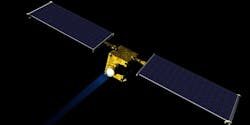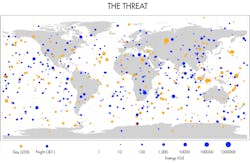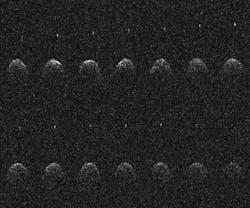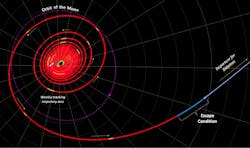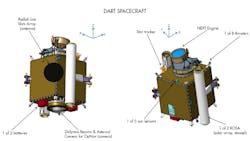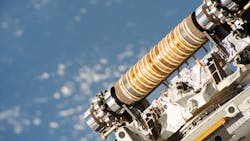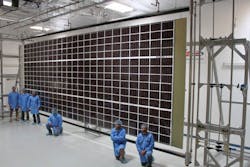NASA Aims to Alter an Asteroid’s Course
No natural disaster is as catastrophic and as seemingly unavoidable as having a good-sized asteroid or comet crash into the Earth. It’s well known and accepted that asteroids of all sizes have been hitting the Earth for millions of years, sometimes with devastating results. , they are widely credited with driving dinosaurs to extinction and instigating a global ice age.
NASA says asteroids, specifically those over one kilometer in diameter, are the greatest threat to life on Earth. The agency knows another large asteroid is bound to hit the Earth eventually. That’s why NASA and other space agencies around the world spend millions of dollars tracking asteroids that could be threats—in particular, those more than 30 meters in diameter that will come within 0.05 AU (4.65 million miles) of Earth.
NASA-funded efforts to find and track potentially deadly asteroids (> 460 ft in diameter) identifies 500 of them annually. Estimates place the total number of such asteroids at about 25,000. So, the threat is real.
The ability to adjust the thrust of the ion-propulsion motor gives the Dart spacecraft a six-month launch window to hit the smaller asteroid on Oct. 7, 2022.
But currently there’s little that can done even if they do discover one on an imminent collision course with Earth. But space agencies have been working on contingency plans.
One such plan will be tested on Oct. 22, 2022. That’s when NASA’s Dart (double asteroid redirection test) spacecraft is scheduled to crash into the smaller asteroid of the binary pair called Didymos (Greek for “twin”). The hope is that the impact will alter the smaller asteroid’s course and give astronomers and engineers hope they can safely divert an Earth-bound asteroid from hitting its initial target.
This diagram maps data gathered from 1994 through2013 on asteroids entering Earth’s atmosphere to create bright meteors (technically called “bolides” and commonly referred to as “fireballs”) .Red dots (daytime events) and blue dots (nighttime events) are sized to reflect the optical radiated energy they generated measured in billions of Joules (GJ) and show the event’s location of objects from about 1 meter (3 feet) to almost 20 meters (60 feet) in diameter. (Courtesy: Planetary Science)
The Target
The Didymos asteroid pair was discovered in 1996 but it wasn’t until astronomer’s got telescopes and imagers with greater resolution (2006) that they realized it was a binary system of asteroids. It turns out there is a smaller, sister asteroid orbiting 3,870 ft from the larger one once every 11.9 hours. (About one-sixth of the known asteroids near Earth are binary or multi-body systems.)
The larger asteroid, Didymos A, is about 2,625 ft in diameter, while the smaller, Didymos B (also known as Didymoon) measures 490 ft in diameter. They orbit the sun in a path that circles out to 2.27 AU at its farthest from the sun and sweeps in to within 1.01 AU at its closest approach. It takes 2.11 years for the two to circle the sun. In October 2022, they will be roughly 6.6 million miles away from Earth and within sight of many Earth-based telescopes and radars.
These 14 radar images taken at the Arecibo telescope of the Didymos binary asteroid shows the larger asteroid, Didymos A, being orbited by the smaller one, Didymos B (also called the Didymos or Didymos moonlet) in 2003. Using other radar images and photometric lightcurve data let astronomers determine it was a binary (two-asteroid) object and resolve shapes, concavities, and possibly large boulders of the surface of these asteroids. The two asteroids were discovered and though to be one asteroid in 1996. By 2003, scientists had also discovered the smaller asteroid as well, and the binary system was named Didymos, Greek for “twin.”
NASA chose Didymos as the target for Dart because of its configuration as a binary double-asteroid system. As the smaller one revolves around the larger, it changes the amount of sunlight reflected to Earth by 10% twice—once when the moon goes in front of the larger and blocks some of the sunlight, and once when it moves behind the larger and its reflection is blocked.
This phenomenon lets astronomers closely time the orbit of Didymos B around Didymos A. So, after the 1,100-lb Dart rams into the smaller asteroid at 3.7 miles/sec., the asteroid should slow down from its current 7 in./sec. around Didymos A by 0.016 in./sec. This should add roughly 10 minutes to its orbital time around Didymos A. Astronomers on Earth will immediately notice this as the changes in reflected sunlight will change frequency (from twice every 11.9 hr to twice every 11.83 hr).
The Dart spacecraft will be carried aboard a military or commercial launch vehicle and be one of several payloads. It will put in a geosynchronous orbit. The ion thrust engine will push it out beyond geosynchronous satellites and then out of the Earth-Moon system on its way to Didymos AS and B.
There are several reasons Didymos B makes a good target for the test of the anti-asteroid Dart:
- The binary system lets Earth astronomers measure changes in the target’s motion without having to send a secondary observer satellite to tag along.
- As a binary system, when Dart deflects the smaller asteroid, it will remain stay in close orbit around the larger one. So, the path of the two around the sun will be relatively unchanged.
- Spectroscopy indicates Didymos B is an S-type asteroid with a composition similar to common chondrite meteorites. Consequently, it should have the same physical properties as many of the potentially hazardous asteroids. It’s also roughly the same size as the asteroids that make up the most likely threat to the Earth.
- Perhaps most importantly, Didymos is not an Earth-crossing asteroid (Its orbit around the sun never intersects Earth’s orbit around the sun), so there’s no possibility NASA’s experiment will put the asteroid on a collision course with Earth
The Spacecraft
Unlike the sci-fi movie “Armageddon,” NASA is not sending a nuclear explosive to hit Didymos B and change its orbit. Instead, Dart is a kinetic impactor and it relies on its mass and velocity (i.e., momentum) to physically knock Didymos B into another trajectory.
As stated before, the 1,100-lb Dart will be travelling 3.7 miles/sec. when it smacks into the asteroid, which should be going roughly the opposite direction at 7 in./sec. (0.00011048 miles/sec.).
NASA wanted to be sure it does not hit the asteroid too hard. Astronomers do not know the make-up of the Didymos B, so it could be a loose aggregate of gravel and boulders traveling in close formation. A really big hit could break the smaller asteroid into several or several hundred pieces. Then there might be a host of not-as-large asteroids heading toward Earth.
NASA astronomers theorize that an asteroid will remain intact if its speed is not changed by more than its own escape speed. Those types of speed changes are in the range of human technology.
Here's a comparison between the Didymos asteroids and some human-made objects.
So, Dart’s mission is elegantly simple: fly directly into Didymos B after building up speed to 3.7 miles per second. It will steer itself using a sun sensor, star tracker, and a 20-cm aperture camera. The camera is called the Didymos Reconnaissance & Asteroid Camera for OpNav (DRACO for short) and is based on the high-resolution camera developed for New Horizons, the spacecraft that went to Pluto in 2015. The camera will aid in navigation and targeting, as well as picking out a target site and examining the geological content of Didymos B.
Engineers at Johns Hopkins Applied Physics Lab developed the software that will use the camera and sensor inputs to autonomously steer and control Dart’s main engine and eight thrusters. The software, called Small-body Maneuvering Autonomous Real-Time navigation (Smart NAV), as part of the larger Guidance, Navigation, and Control (GNC) algorithm. Smart NAV also handles fuel management, determining the proper times for course corrections so that the limited supply of propellant is used efficiently.
Dart will be powered by a single NASA Evolutionary Xenon Thruster C (Next-C). The thruster uses xenon as the propellant, first ionizing it and then accelerating ions out the engine at up to 90,000 mph using electric fields. This lets the Next-C generate up to 137 mN of thrust (about 0.031 lb) of thrust, which is not much. But the thrusters can operate 24/7 for weeks at a time, letting velocity build.
Dart carries just enough equipment to get to the asteroid and run into it, so there is navigation equipment, one main engine and eight thrusters, solar arrays, batteries, and radio transmitters and receivers. The satellite will be controlled and run at the Johns Hopkins Applied Physics Lab and supported by NASA’s Jet Propulsion Lab, Goddard Space Flight Center, and Johnson Space Center.
NEXT engines are smaller, lighter, simpler, less-expensive, and more fuel-efficient with a specific impulse (Isp) of 4,100 sec., much higher than traditional chemical rockets. (Isp is the ratio between the thrust and the mass of the fuel needed to create that thrust). For comparison, the Merlin 1C rocket engine on Space X’s Heavy Falcon has an Isp of 336. And a Next-C engine consumes 1,918 lb of xenon to generate the thrust created by conventional chemical rocket engine burning 22,000 lb of fuel. Dart can carry 334.5 lb of xenon but will only need a fraction of that to complete the mission.
The low cost of the ion thrusters, coupled with Dart’s relatively small size, should let the mission be launched as secondary payload on a scheduled commercial launch. This should keep the mission price down to $250 million.
NEXT engines can also be throttled so that their thrust can be controlled, letting it put out anywhere from 0.5 to 6.9 kW of power. This will let Dart adjust its speed to ensure is hits Didymos B on Oct. 22, 2022 no matter when it launches in a generous launch window that stretches from Dec. 2020 through May 2021.
Current plans are to launch as soon as possible in the summer or 2021 when the Earth and Didymos are in close proximity. There are at least 21 dates in this period and NASA can slide the mission launch to one of the later slots if there are weather or maintenance delays.
Though Dart will carry a lithium battery, it will only supply electricity to the spacecraft until it can unfurl its solar arrays.
Those solar arrays represent new technology getting their first real mission. Dart will carry two Roll Out Solar Arrays (ROSAs), components that were tested on the Space Station in 2017.
Dart will carry the roll-out solar arrays developed a Deployable Space Systems. They save weight and volume when packed onboard a spacecraft before launch. And they provide more electricity per square foot than traditional solar arrays.
ROSA uses flexible, blanket-like solar panels that can be rolled up like a sleeping bag and stowed in a smaller container for launch. It no longer relies on heavy and stiff glass panels that need to be equipped with hinges and unfolded in orbit using motors and other mechanisms. Each array has a center wing that supports the string of photovoltaic cells. The arrays also have narrow high-strain composite booms running the length of the array. When stowed for travel, the booms are coiled up lengthwise and act like springs: They want to unwind and deploy the blanket of solar cells as they do so.
So once in space, the arrays self-deploy with no need for a motor, and the booms click into place, locking the arrays in their unfurled configuration. The wing carrying the arrays measures 7.5 ft wide by 28.2 ft long; all together they provide 242.5 ft2 of solar cells that will generate 5.4 kW at one AU from the sun when brand-new. It is larger than a conventional solar array of the same power, but weighs 20% less and rolls up into a volume one-fourth the size of conventional arrays when packed into the spacecraft. It’s estimated that a ROSA-equipped Next-C could power a Dart-sized satellite to 201,000 mph, five times faster than the Voyager 1’s top speed.
There are also plans for Dart to carry a CubeSat dubbed Licia (Light Italian CubeSat for Imaging Asteroids) built by the Italian Space Agency. It will “jump” off Dart just before it crashes into the asteroid and to take pictures of the actual impact and the crater Dart leaves behind. It’s estimated Dart will leave a 20-m crater on the face of Didymos B. Mapping the shape of this crater will provide unique information to validate the numerical impact models necessary to design asteroid-deflection missions in future.
The European Space Agency also has a spacecraft, Hera, that will make a flyby of the Didymos Asteroids a few years later. It will carry out a more detailed reconnaissance, including more accurately measuring the velocity change and orbital shift in the Didymos binary system due the impact from Dart.
